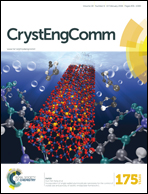A low-temperature formation path toward highly efficient Se-free Cu2ZnSnS4 solar cells fabricated through sputtering and sulfurization†
Abstract
A novel low-temperature Cu2ZnSnS4 (CZTS) formation path using co-sputtered SnS2–ZnS–Cu precursors was employed for CZTS solar cell fabrication, which gave rise to a cell with a power conversion efficiency of 8.58%, a big step forward from the previous record of 6.77% reported by Katagiri et al. for this kind of solar cell. This method consists of a low-temperature annealing stage for CZTS phase formation followed by a short high-temperature annealing stage for grain growth and secondary phase removal. The employment of SnS2 as a precursor causes the CZTS phase to readily form at low temperature when SnS2 has not dramatically decomposed into volatile SnS. The two-stage process wisely separates the phase formation and crystal coalescence, which makes the fabrication of CZTS films more controllable. Furthermore, the demonstration of the low-temperature formation path provides new opportunities to fabricate highly efficient, cost-effective and environmentally friendly CZTS solar cells on low-weight and flexible substrates such as polyimides.


 Please wait while we load your content...
Please wait while we load your content...